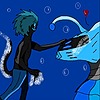HOME | DD
 Vitor-Silva — Pelagiarctos
Vitor-Silva — Pelagiarctos

#pinniped #mammal #paleoart #prehistoric #seal #sealion #walrus #paleoartist
Published: 2018-11-06 22:45:49 +0000 UTC; Views: 4752; Favourites: 123; Downloads: 0
Redirect to original
Description
Despite this supposed life appearance (the fossils are fragmentary), Pelagiarctos thomasi is not a sea lion, but a "primitive walrus".The animal was described in 1988 based on part of the mandible, including some teeth. The fragment was still enough to show peculiar features regarding this new species' ecology: Pelagiarctos would have been a superpredator, with jaw and teeth reinforced to hunt big prey (that is, a macrophage), like, for example, other pinnipeds. It was also initially considered an Otariidae, a member of the family of sea lions and fur seals.
In 2013, a new fossil (again of the jaw, this time more complete) offered a better understanding about this mammal. The authors found that it was, in fact, a type of primitive walrus, diverging early in the history of the Odobenidae family, and did not identified in the new fossil macrophage specializations. They also questioned whether the features seen and inferred from the first mandible actually indicate such a specific diet, and compared to other animals - concluding that they, most probably, did not. They understood, therefore, that Pelagiarctos had a more generalist diet than originally thought.
Although clearly similar to the holotype described in 1988, the new mandible was attributed to Pelagiarctos sp., Not P. thomasi, due to small differences - for example, it did not had the fused mandibular symphysis, one of the previously supposed macrophage specializations.
While it is considered a "primitive walrus", it is reconstructed somewhat different from the modern walrus (Obodenus), without the enormous canines. This reflects the basal state of the animal within its family, still resembling the likely common ancestor of Odobenidae and Otariidae. This appearance, with "normal" canines, is observed in close relatives known from more complete fossils, like Archaeodobenus or the recently described Titanotaria (the description of both brings considerations to the classification of Pelagiarctos within the family, which is problematic given the absence of the skull).
Cold porcelain, 1:12 scale.
More photos: vitorsilvapaleoartista.blogspo…
Related content
Comments: 6

Great reconstruction! Interesting to learn about early walrus diversity.
👍: 0 ⏩: 1

It should be noted that pinnipeds in general often take down much larger prey than pop culture has it, so Pelagiarctos opportunistically eating other marine mammals is still likely; after all, Steller's sea lions and grey seals do it, and even harbour seals have preyed on waterfowl.
Hell even walrus, which are definitely molluscivores, will sometimes kill and eat seals!
👍: 0 ⏩: 1

Trivial for the context. The description just tells how researchers found it to be a generalist, not a specialized macrophage as initially believed.
👍: 0 ⏩: 1


















